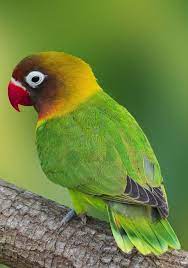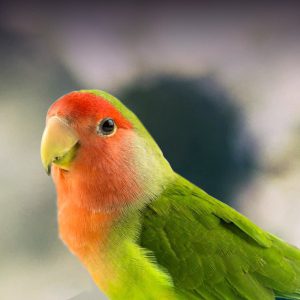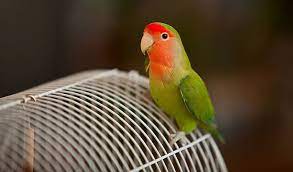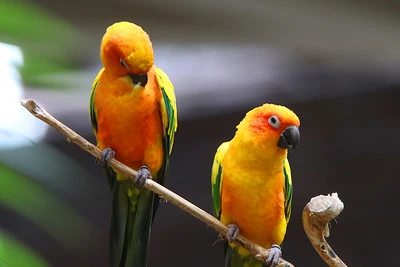Explore the world do lovebirds make good pets! Discover their charming personalities, care needs, and whether these colorful birds are the ideal .
Introduction
Lovebirds: Charming Companions in the Avian World
Welcome to the world of lovebirds – charming and affectionate feathered friends that have captured the hearts of bird enthusiasts and pet lovers alike. In this introductory chapter, we will embark on a journey to explore the appeal of lovebirds as pets and the crucial importance of selecting the right avian companion for your household. Whether you’re a seasoned pet bird owner or considering bringing a feathered friend into your life for the first time, this article aims to provide you with valuable insights into the world of lovebirds.
The Appeal of Lovebirds as Pets

Lovebirds have earned their place in the avian world as affectionate and sociable pets. The allure of these small parrots lies in their endearing personalities and unique characteristics. As a pet owner, you’ll find lovebirds to be not only visually captivating but also emotionally rewarding.
- Affectionate Nature: Lovebirds are known for their deep affection and attachment to their human companions. Their willingness to form strong bonds with their owners makes them highly sought-after as pets.
- Vibrant Personalities: Lovebirds exhibit vibrant and charming personalities, often displaying playfulness and curiosity. These traits make them delightful and entertaining additions to your home.
- Intelligence and Trainability: Lovebirds are intelligent birds that can be trained to perform tricks and even mimic sounds. Their quick wit and ability to learn new behaviors add to their appeal.
The Importance of Choosing the Right Pet Bird
Selecting the ideal pet bird is a decision that should not be taken lightly. It involves considering factors such as your lifestyle, living space, and personal preferences. Lovebirds are just one of the many options available, and it’s essential to make an informed choice.
- Compatibility: Assess your compatibility with lovebirds based on the time and attention you can provide. Lovebirds thrive on social interaction and bonding, making them well-suited for those willing to invest time in their care.
- Living Space: Consider the size of your living space and whether it can accommodate a lovebird’s cage. Adequate room for flight and exercise is crucial for their well-being.
- Commitment: Owning a pet bird, including lovebirds, requires a long-term commitment. They can have a lifespan of up to 20 years, so be prepared for a lasting companionship.
What to Expect in This Article
This article is structured to provide you with a comprehensive understanding of lovebirds as pets. We will delve into various aspects, from their behavior and characteristics to the pros and cons of having lovebirds in your home. By the end of this journey, you will be well-equipped to make an informed decision about whether lovebirds are the right pet birds for you.
Understanding Lovebirds
In our journey to explore the world of lovebirds as potential pets, it’s crucial to gain a comprehensive understanding of these charming avian companions. In this chapter, we will delve into the specifics of lovebirds, including their brief overview, various species and varieties, behavior, and unique characteristics that set them apart in the avian world.
Lovebirds: A Brief Overview
Lovebirds, scientifically classified as Agapornis, are small parrots known for their vibrant colors and captivating personalities. While they are relatively smaller in size compared to some other parrot species, their endearing characteristics make them stand out. Let’s take a closer look at some key features of lovebirds:
- Visual Appeal: Lovebirds come in a variety of colors, from bright green to striking red, yellow, and orange. Their colorful plumage adds an aesthetic charm to any avian collection.
- Compact Size: These parrots are petite in size, typically measuring between 5 and 7 inches in length. Their diminutive stature makes them an excellent choice for those with limited living space.
- Distinctive Features: Lovebirds are recognized for their unique beak shape, which is short and robust. They also have a vibrant eye ring and a prominent core, which distinguishes them from other parrot species.
Lovebird Species and Varieties

Lovebirds are not a monolithic group; instead, they encompass various species and subspecies, each with its own characteristics and charm. Some of the most popular lovebird species and varieties include:
- Peach-Faced Lovebirds: Known for their vibrant peach face, these lovebirds are cherished for their playful and cheeky demeanor.
- Fischer’s Lovebirds: Fischer’s lovebirds are characterized by their striking green plumage and a distinctive orange face.
- Masked Lovebirds: With their black facial mask, these lovebirds have a unique and mysterious appearance.
- Lilian’s Lovebirds: These lovebirds are smaller in size and often exhibit a gentler disposition.
- Nyasa Lovebirds: Nyasa lovebirds are notable for their striking red plumage and engaging personalities.
Lovebird Behavior and Characteristics
Understanding the behavior and characteristics of lovebirds is essential when considering them as pets. Lovebirds are known for their sociable and lively nature. Here are some key aspects of their behavior:
- Social Interaction: Lovebirds thrive on social interaction, and they form deep bonds with their human companions. They enjoy being part of the family and participating in daily activities.
- Playfulness: Lovebirds are inherently playful and require mental stimulation and physical activity. Providing them with toys and opportunities for play is essential for their well-being.
- Vocalization: Lovebirds are not as loud as some larger parrot species, but they are not entirely silent either. They communicate through chirps, whistles, and occasional squawks.
The Social Nature of Lovebirds
One of the most endearing qualities of lovebirds is their social nature. They thrive on companionship, and they are often best kept in pairs or as part of a larger avian flock. Lovebirds not only form strong bonds with their human owners but also with each other, which adds to their charm as pets.
- Pair Bonding: Lovebirds often form strong pair bonds, and they are known to preen each other, snuggle together, and even feed one another as signs of affection.
- Potential for Loneliness: When kept alone, lovebirds can become lonely and stressed. It’s essential to provide them with ample attention and interaction.
- Compatibility with Other Birds: Lovebirds can coexist with other bird species, but introductions should be gradual and monitored to ensure harmony within the aviary.
Pros of Having Lovebirds as Pets
Lovebirds, with their endearing personalities and striking appearances, are beloved avian companions. In this chapter, we’ll explore the many advantages of welcoming these small parrots into your home. From their affectionate nature to their intelligence and low maintenance requirements, lovebirds offer a host of benefits for pet owners.
Lovebirds’ Affectionate Nature
One of the most significant pros of having lovebirds as pets is their remarkable affectionate nature. These small parrots are known for forming deep emotional bonds with their human companions. Here are some key points to consider:
- Bonding with Owners: Lovebirds are highly social and thrive on companionship. They enjoy spending time with their human family members and often seek physical closeness.
- Displays of Affection: Lovebirds show their affection through behaviors like preening, cuddling, and gentle nibbling. Their loving gestures can create a strong emotional connection between pet and owner.
- Loyal Companions: Lovebirds are loyal and often become devoted to their owners. This loyalty can lead to a strong and lasting bond that brings joy to both the bird and its human family.
Intelligence and Trainability
Lovebirds are not only adorable but also intelligent birds. Their quick wit and ability to learn new behaviors make them appealing to pet owners interested in interactive and mentally stimulating companions. Here’s what you need to know:
- Quick Learners: Lovebirds have a knack for picking up tricks and commands, which can make training sessions enjoyable and rewarding for both bird and owner.
- Mimicry: While they may not have the extensive vocabulary of some larger parrot species, lovebirds are often capable of mimicking sounds and words. They can surprise you with their vocal abilities.
- Mental Stimulation: Keeping lovebirds mentally engaged is essential to their well-being. Puzzle toys, challenges, and interactive playtime can satisfy their intelligence.
The Joy of Companionship
Lovebirds are known for the happiness they bring to their owners’ lives. Their vibrant personalities and playful antics can create a joyful atmosphere in your home. Consider the following aspects:
- Entertaining Personalities: Lovebirds are often described as little bundles of joy. Their playful and mischievous behavior can bring laughter and amusement to your daily routine.
- Positive Vibes: The positive energy lovebirds exude can be contagious. Their enthusiasm for life can lift your spirits and provide a sense of well-being.
- Emotional Support: Lovebirds, with their affectionate nature, can provide emotional support and companionship. They are there for you in times of happiness and comfort you during challenging moments.
Compact Size and Low Maintenance
Lovebirds’ petite stature is a practical advantage for those with limited living space. Their relatively low maintenance requirements make them accessible to a wide range of pet owners. Here’s what to consider:
- Space Efficiency: Lovebirds don’t demand a massive cage or a vast living area. Their compact size allows them to thrive in smaller accommodations, such as apartments or homes with limited space.
- Dietary Simplicity: Their dietary needs are straightforward, primarily consisting of a high-quality seed mix, fresh fruits, and vegetables. This simplicity makes caring for them less daunting.
- Cleaning Ease: Lovebirds are not excessively messy, and their cages are relatively easy to maintain. Regular cleaning routines help keep their living environment clean and hygienic.
In conclusion, the pros of having lovebirds as pets are numerous, from their affectionate nature to their intelligence and low maintenance requirements. However, it’s essential to understand the cons and consider them alongside these advantages to make an informed decision about whether lovebirds are the right avian companions for you,
Cons of Having Lovebirds as Pets

While lovebirds have many admirable qualities as pets, it’s essential to consider the potential drawbacks before welcoming them into your home. In this chapter, we’ll explore some of the cons associated with having lovebirds as companions.
The Messy Side of Lovebirds
As with many pets, lovebirds come with their fair share of messiness. Here are some aspects to be aware of:
- Feather Dust: Lovebirds produce a fine feather dust as they preen. This dust can settle on surfaces in your home, requiring regular cleaning to maintain cleanliness.
- Food Scatter: Lovebirds can be quite enthusiastic eaters. They may scatter food and debris around their cage, leading to some cleanup after mealtime.
- Cage Maintenance: Cleaning their cage is necessary to prevent the buildup of waste and debris. Regular cage cleaning is vital for your lovebird’s health and comfort.
Attention and Interaction Requirements
Lovebirds are social and thrive on interaction with their human family members. However, their need for attention and engagement can be challenging for some pet owners. Consider the following:
- Time Demands: Lovebirds require daily interaction and mental stimulation. If you have a busy schedule, meeting their social needs might become a challenge.
- Loneliness: If not given sufficient attention, lovebirds can become lonely and may exhibit undesirable behaviors, such as excessive screaming or feather plucking.
- The Need for a Companion: Some pet owners choose to keep multiple lovebirds to address their social needs. However, this can lead to a larger commitment and more responsibilities.
Potential for Aggression
Lovebirds are known for their strong personalities, which can sometimes manifest as aggression. Here are some points to consider:
- Territorial Behavior: Lovebirds can be territorial and may exhibit aggressive tendencies, especially in their chosen nesting areas. This aggression can extend to their human family members.
- Protective Instinct: Lovebirds may become protective of their owners, which can lead to aggressive behaviors towards others, including family members or visitors.
- Biting: Lovebirds are capable of delivering painful bites, especially when they feel threatened or agitated. This behavior may be a challenge for novice bird owners.
Lifespan Considerations
It’s important to note that lovebirds can have a long lifespan, and potential owners should be prepared for the commitment this entails. Consider these factors:
- Longevity: Lovebirds can live for 10 to 15 years or more, depending on their species and care. This long-term commitment should be thoughtfully considered.
- Changing Life Circumstances: Over a decade, your life circumstances can change significantly. Consider if you can commit to the care of your lovebird over the years, even as your life evolves.
- Financial Responsibility: Lovebirds, like all pets, come with ongoing financial responsibilities for food, healthcare, and other essentials. Ensure you are financially prepared for this commitment.
In conclusion, lovebirds, while wonderful pets, do come with certain cons, including messiness, attention and interaction demands, potential for aggression, and the long-term commitment their lifespan requires. Understanding these drawbacks is essential for making an informed decision about whether lovebirds are the right pet for you.
The Ideal Lovebird Owner

Lovebirds are delightful companions, but they aren’t the perfect fit for everyone. In this chapter, we’ll delve into the qualities that make an ideal lovebird owner and explore the nuances of living with these charming birds.
Are Lovebirds Suitable for Beginners?
Lovebirds may be affectionate, but they’re not always the best choice for beginners in the world of avian companionship. Here’s what you need to consider:
- Experience Matters: Lovebirds can be a bit challenging for first-time bird owners. They require a good understanding of avian care, including nutrition, socialization, and handling.
- Alternative Options: If you’re new to bird ownership, you might want to start with a more beginner-friendly species, such as budgerigars or cockatiels.
- Enthusiastic Learners: If you’re committed to learning about lovebirds and are willing to invest time in their care, they can still be an option. Just be prepared for a bit of a learning curve.
The Importance of Pairing Lovebirds
Lovebirds are incredibly social creatures, and their need for companionship is one of their defining characteristics. Here’s why pairing is essential:
- Inseparable Bonds: Lovebirds get their name from their strong, inseparable bonds with their mates. Without a companion, they may become lonely and stressed.
- Pair Dynamics: Two lovebirds often form a close-knit pair, preening each other and sharing their days together. Their playful interactions can be heartwarming.
- Reduced Loneliness: When lovebirds have a mate, they are less likely to exhibit undesirable behaviors like excessive screaming or feather plucking.
Taming and Bonding with Lovebirds
Building a strong and trustful relationship with your lovebird is key to a harmonious coexistence. Here’s how to foster that connection:
- Patience and Consistency: Taming lovebirds requires patience and consistent efforts. Spend time with them daily, and they’ll gradually become more comfortable with your presence.
- Positive Reinforcement: Use positive reinforcement techniques to reward desirable behaviors. Lovebirds respond well to treats and praise.
- Respect Their Boundaries: Lovebirds may not enjoy being touched or handled like some other pets. Respect their boundaries and let them dictate the pace of interaction.
Lovebirds in a Family Setting
If you’re considering lovebirds as family pets, there are a few important considerations:
- Child-Friendly Species: Lovebirds are relatively small and may not be as robust as larger parrots. Supervision is essential when children and lovebirds interact.
- Noise Tolerance: Lovebirds can be noisy, especially when they’re excited or alarmed. Make sure your family members are tolerant of the sounds they may produce.
- Commitment from All: The care of lovebirds should be a family commitment. Discuss responsibilities and ensure everyone is on board with the care required.
In conclusion, lovebirds can make wonderful pets when matched with the right owner. While they may not be the best choice for beginners, they thrive in the company of a mate, and a patient, dedicated owner can build a strong bond with these charming birds. If you’re considering lovebirds for your family, be prepared for their unique characteristics and the responsibilities that come with them.
Addressing FAQs
In this chapter, we’ll dive into some frequently asked questions to address common concerns and provide clarity on the topic of lovebirds as pets.
Do Lovebirds Make Good Pets for Kids?
Lovebirds can be a delightful addition to a family, but is their vivacious nature suitable for children?
- Supervision is Key: Lovebirds are relatively small, and their energetic behavior can sometimes lead to accidents if not properly supervised around young children. It’s crucial to ensure kids handle them gently and are supervised during interactions.
- Social Interaction: Lovebirds do appreciate companionship, but they may not be the most interactive pets for young kids. They’re not typically inclined to be cuddled like a dog or a cat.
- A Learning Opportunity: Lovebirds can offer a valuable lesson in responsibility for children, teaching them about the care and respect required for pet ownership.
Lovebirds as Pets for Beginners
For those new to avian companionship, are lovebirds a suitable starting point?
- Learning Curve: Lovebirds are not as straightforward as some other beginner bird species like budgerigars. Their care and handling can be a bit more challenging.
- Commitment: Being a pet owner is a long-term commitment. For beginners, it might be prudent to start with a more forgiving and low-maintenance species to get acclimated to the responsibilities of pet ownership.
- Seek Advice: If you’re determined to make lovebirds your first pet, seek advice from experienced bird owners or avian experts to ensure you’re well-prepared.
Pros and Cons of Lovebirds as Household Pets
Every pet has its advantages and disadvantages. Here’s a concise overview:
Pros:
- Affectionate Nature: Lovebirds can form strong bonds with their owners, providing companionship and affection.
- Intelligence: These birds are intelligent and can be trained to perform tricks and respond to commands.
- Compact Size: Lovebirds are smaller than many other parrot species, making them a great choice for those with limited space.
- Low Maintenance: While they do require social interaction, they are not as high-maintenance as some other pets.
Cons:
- Messiness: Lovebirds can be messy eaters, and their feathers and seeds may litter the area around their cage.
- Attention Requirements: They need social interaction and mental stimulation. Neglecting this can lead to behavioral issues.
- Potential for Aggression: Some lovebirds can become territorial or display aggressive behavior, which requires careful handling and socialization.
The Benefits of Keeping Lovebirds at Home
While lovebirds may have their challenges, there are also compelling reasons to bring them into your home.
- Entertainment: Lovebirds are amusing to watch with their playful antics and interactions.
- Companionship: If you’re looking for a loyal and affectionate companion, lovebirds can offer just that.
- Learning Experience: Owning lovebirds can be a rewarding educational experience for families and individuals, teaching responsibility and patience.
Conclusion
As we wrap up our journey through the world of lovebirds as potential pets, it’s time to reflect on the insights we’ve gathered and consider the path forward.
Final Thoughts on Lovebirds as Pets
In conclusion, lovebirds have distinctive qualities that can make them wonderful companions for the right individuals and families. Their affectionate nature, intelligence, and compact size are certainly appealing attributes. However, their suitability as pets depends on various factors, including your lifestyle, expectations, and level of commitment.
Assessing Your Lifestyle: Before bringing lovebirds into your home, evaluate your daily routine and living situation. Lovebirds require daily social interaction and a clean environment. They thrive in an environment where they can be mentally stimulated and have opportunities to bond with their owners.
The Importance of Patience: Taming and bonding with lovebirds can be a rewarding but gradual process. Patience is key, especially if you’re new to avian companionship. Expect some trial and error as you build a trusting relationship with your feathered friends.
Family Considerations: If you have a family, involve everyone in the decision-making process. Lovebirds can fit well into family settings, but it’s crucial that all family members understand the responsibilities and commitments involved in pet ownership.
Making an Informed Decision
When contemplating lovebirds as potential pets, make sure you’re well-informed. Reach out to experienced bird owners, avian experts, and veterinarians to gather insights and advice. Consider visiting an avian rescue or a breeder to interact with lovebirds in person, giving you a better understanding of their behavior and personality.
Embracing the Joy of Lovebird Companionship
If you decide to bring lovebirds into your life, get ready for an incredible journey filled with companionship, learning, and affection. Building a bond with these charismatic birds is a unique experience that can lead to years of joyful moments.
Remember that, like any pet, lovebirds are individuals with their own personalities and quirks. Embrace their uniqueness and enjoy the special connection you’ll share with these feathered friends.
